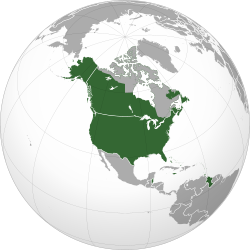 | |
| Area | 14,655,937.6 km2 (5,658,689.1 sq mi) (area excludes Quebec and Inuit Nunangat) |
|---|---|
| Population | 348,006,606 (population excludes Quebec and Inuit Nunangat) |
| Population density | 23.74/km2 (61.5/sq mi) |
| Demonym | Anglo-American [1] |
| Countries | |
| Dependencies | |
| Languages | English |
| Time zones | UTC−03:30 to UTC-10 |
| Largest cities | List of cities in North America, cities in Guyana |
Anglo-America most often refers to a region in the Americas in which English is the main language and British culture and the British Empire have had significant historical, ethnic, linguistic, and cultural impact. [2] This includes the United States, most of Canada, and some Caribbean countries. Anglo-America is distinct from Latin America, a region of the Americas where Romance languages (e.g., Spanish, Portuguese, and French) are prevalent. [2] The adjective is commonly used, for instance, in the phrase "Anglo-American law", a concept roughly coterminous with common law. [3] [4]
